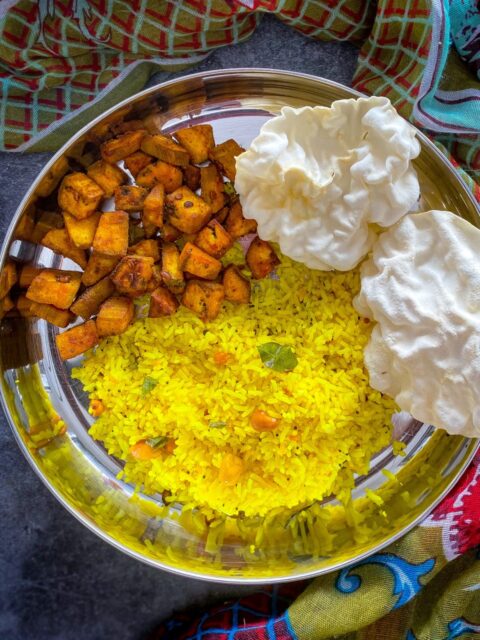Living far away from home, thousands of kilometers away, can be a challenging and emotional experience, but the food we grew up eating has the power to bring us comfort and a sense of home. A meal of steamed rice, turmeric-hued kalatthu paruppu, sambar, rasam, and a side of vegetable stir-fry (Kari/poriyal) or stew (koottu) and appalam is so close to my heart and takes me back to my childhood days when my mother would prepare elaborate meals and pack mine and my sister’s lunch boxes every single day. Years later, I have come to appreciate the love and effort that went into cooking healthy meals for our family. Home-cooked Indian food is humble, nutritious, and uses grains, lentils, fresh seasonal vegetables, greens, and tubers. It is far from the extravagantly rich curries and heavy flatbreads that are often portrayed in the popular media. Most recipes are simple, hearty, and naturally vegan or vegetarian, providing nourishing benefits to the body and soothing to the soul. For those who grew up eating lemon rice, tamarind rice, sambar, rasam or poriyal – these dishes are staples in South Indian households and a reminder of the warmth and care received from family.
Replicating these recipes and adding my own twist to them with the kind of vegetables and spices that I have access to in this part of the world makes the experience therapeutic and fun. To me, eating homemade food is a way of passing down traditional recipes to the next generation, even when we are far away from home.

Elumichampazham Sadham | Lemon Rice
A popular South Indian dish made with fluffy rice, lemon, and spices.
Ingredients
- Rice: 1 cup
- Oil: 1 tsbp
- Mustard seeds: 1 tsp
- Urad dal: 1 tsp
- Chana dal: 1 tsp
- Roasted peanuts: 1 tbsp
- Dried red chili: 1 whole
- Green chilies: 2, chopped
- Chopped ginger: ½ tsp
- Turmeric powder: ½ tsp
- Curry leaves: 10-12
- Salt: 1½ tsp or to taste
- Lemon Juice: 1 whole lemon
Method:
- In a pan, heat oil over medium heat.
- Add mustard seeds, urad dal, chana dal, and dried red chili. Fry until the mustard seeds crackle.
- Add roasted peanuts to the pan.
- Add curry leaves, green chilies and ginger and fry for another 30 seconds.
- Add the turmeric powder and cooked rice to the pan and mix well with the tempered spices.
- Add salt to taste.
- Turn off the heat and add lemon juice. Mix well.
- Serve hot with a crispy pan-fried vegetable and appalam.
Vazhakkai Kari | Green Banana Stir-fry
A simple, tangy, and spicy stir-fry recipe made with raw plantain and spices.
Ingredients
- 2 raw plantains, peeled and chopped into small cubes
- Mustard seeds: 1 tsp
- Urad dal: 1 tsp
- Asafetida: ¼ tsp a
- A few curry leaves
- Tamarind extract: ½ tsp
- Sambar powder: ½ tsp (optional)
- Turmeric powder: ½ tsp
- Coriander powder: ½ tsp (optional)
- Red chili powder: ½ tsp
- Salt to taste
- Oil: 2 tbsp
Method:
- Heat oil in a pan and add the mustard seeds, urad dal seeds, asafetida, and curry leaves.
- Add the chopped plantain to the pan and mix well.
- Add the turmeric powder, coriander powder, red chili powder, and salt to the pan and mix well with the plantain.
- Add tamarind extract and a splash of water. Cover with a lid and cook for about 10-15 minutes on low heat, stirring occasionally.
- Check if the plantain is cooked through.
- Once the plantain is cooked through and the mixture is dry, turn off the heat.
- Serve hot with lemon rice, rasam rice, tamarind rice or curd rice.
Watch this recipe here – Elumichampazham Sadham & Vazhakkai Kari

My name is Poornima. I was born in New Delhi and raised in Chennai, and my love for food is deeply influenced by my childhood, my mother’s cooking, my South Indian heritage and all the places I have lived and traveled. I am an engineer by profession and a full-time working mother to a toddler and a German Shepherd dog. Currently, I reside in Canada with my family.
I started @deepfriedbread with the intention of capturing pictures and recipes of the everyday food that I prepared for my family. I shoot and style my thalis, sapadu platters, quick one pot meals and this hobby of mine has turned out to be an effective way to channelize my creativity. I love to share the vegetarian and vegan recipes that my family loves in the caption of my posts and be a part of a growing community of enthusiastic home cooks and food entrepreneurs on Instagram.
Translations and detailed descriptions are provided to give a better understanding of the story to people from different cultural backgrounds across the globe.

